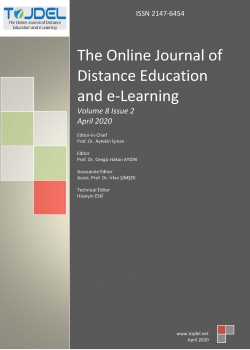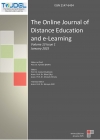TOJDEL - Volume 8 - Issue 2 - April 2020
 BLENDED LEARNING - A STUDY ON STUDENT’S PERCEPTION ABOUT SUITABILITY OF THE FRAMEWORK FOR HIGHER EDUCATION
BLENDED LEARNING - A STUDY ON STUDENT’S PERCEPTION ABOUT SUITABILITY OF THE FRAMEWORK FOR HIGHER EDUCATION Pallavi Ughade (Badre), Shailesh Badre
Abstract:
In today’s digital era, use of technology and web based means of communication have provided an opportunity to educators, all over the world to investigate the most suitable learning environment which may cater the needs of diverse learner. Modified learning environment which incorporates the benefits of traditional as well as modern learning is the need of hour.
New opportunities for learning and engagement in life are offering of globalization and technology which is continually altering our views of education. Technology enables learning extend beyond the classroom walls and facilitates better access to learning resources. Blended learning approaches have amplified the need for teachers, students and the wider community to take advantage of learning opportunities afforded through improved personalization, collaboration, and communication enabled by learning technologies. Blended learning has many different forms and it will continue to evolve. New practices will be introduced to increase its reach and effectiveness. It should not be viewed as a single model but as an approach that shares the ultimate goal of the provision of better educational experiences and outcomes. Blended learning provides flexible, cost effective and time saving for the learners and teachers.
The main aim of the study is to find out the perception of students towards Blended Learning. Survey method was employed for this research. The researcher has chosen 75 PG students for the study. The researcher found that median is 4 for all the structured questions used in the questionnaire. Outcome has absolute characteristics irrespective of gender. Hence blended learning is a suitable and effective method for the better learning in higher education.
 COGNITIVE MAPPING FOR ILOOKOUT FOR CHILD ABUSE: AN ONLINE TRAINING PROGRAM FOR EARLY CHILDHOOD PROFESSIONALS
COGNITIVE MAPPING FOR ILOOKOUT FOR CHILD ABUSE: AN ONLINE TRAINING PROGRAM FOR EARLY CHILDHOOD PROFESSIONALS Karl M. Kapp, Sarah Dore, Richard Fiene, Breanna Grable, Carlomagno Panlilio, Robert M. Hamm, Chengwu Yang, Erik B. Lehman, Claudia Mincemoyer, Nicole Verdiglione, Benjamin H. Levi
Abstract:
This article delineates the theory and framework for an innovative child abuse training program for mandated reporters called 'iLookOut'. iLookOut is an online learning delivery system that utilizes mastery learning and self-determination theory in the Core Training program, along with spaced retrieval and retrieval practice in a follow-up micro-learning program that reinforces learning from the Core Training. A cognitive mapping model provides the structure for documenting and organizing the learning content in both the Core training and the follow-up micro-learning program. The article provides a conceptual framework for designing and implementing effective and efficient online learning programs.
 EFFECTS OF SOCIAL MEDIA ON ACADEMIC PERFORMANCE OF THE STUDENTS
EFFECTS OF SOCIAL MEDIA ON ACADEMIC PERFORMANCE OF THE STUDENTS R. Sivakumar
Abstract:
Social Media are growing rapidly among the young generation of the world. School age students widely engaged using Social Media. So, they will affect students personal and academic live. Thus, this study is designed to find out the Effects of Social Media on the academic performances of students in Cuddalore District. Survey method was adapted to collect the relevant data for the study. 1000 were selected as sample. Random sampling technique was employed for sample selection. Subsequently, Statistical Technique was applied to analyze the data. It was concluded that in despite of public views concerning the misuse of social media among students in the society, most of the school students were interested to use social media positively for their academic purpose. This indicates that the social media impacts the academic performance of the students. Therefore the social media contributes to improve the academic performance of the students. However, results of ANOVA showed that there is significant differences between academic achievement and impact of social media among Students. Teacher Educators and students can use social media as teaching and learning tool to ease and improve learning process.
 EXPLORING THE TEACHER AND LEARNER PERCEPTIONS OF A TECHNOLOGICAL FRIENDLY CLASSROOM
EXPLORING THE TEACHER AND LEARNER PERCEPTIONS OF A TECHNOLOGICAL FRIENDLY CLASSROOM V. S. Sumi, Shaheen A. Shaikh
Abstract:
Technology holds a relevant and unique place in the school curriculum as it is important for a better living of the individual. But, it is known that most of the teachers are considering technology handling as difficult. This study examines the perception by secondary school students and teachers in technology integrated learning and teaching. Sixty secondary school students and fourteen teachers participated in the survey. The questionnaires on perception of students and teachers used to collect the data and comprises of closed as well as open ended items. The study incorporated cognitive, affective and environmental reasons that contribute to perception about technology integration. The factors that make difficult for the teachers include distraction, ICT support, Infrastructure, Professionalism. Further analysis revealed that students’ responses include both positive and negative. Little variation in teaching, lack of knowledge in handling, too fast class, are some of the negative responses from the students. According to teachers, students’ lack of effort and prerequisites are the major reasons for keeping away the technology integration in classroom instruction. Reluctance to seek help from others, inattention in the classroom and students’ distraction were also perceived to contribute toward why there is unsuccessful integration of technology. Teachers reported also that, lack of infrastructure and professionalism are causing main huddle in this. The findings indicate the need for teachers to realize the importance of making technology integrated classroom interesting for students to take effort in learning it. The result is discussed in relation to students’ perception in classroom teaching.
 STUDENTS’ NEEDS SATISFACTION WITH ASYNCHRONOUS ONLINE VIDEO LECTURES IN THE FLIPPED CLASSROOM ENVIRONMENT
STUDENTS’ NEEDS SATISFACTION WITH ASYNCHRONOUS ONLINE VIDEO LECTURES IN THE FLIPPED CLASSROOM ENVIRONMENT Thanthawi Ishak, Rudi Kurniawan, Zanzibar Zanzibar, Mulia Andirfa, Cut Muftia Keumala
Abstract:
The study attempts to identify what motivates university students to study in the flipped classroom environment using asynchronous online video lectures (AOVL). A mixed-method research approach was applied in collecting the data. The data on students' learning experiences and attitudes were collected through questionnaire surveys and focus group interviews. Thirty-one respondents participated in the questionnaire surveys and 10 respondents were voluntarily interviewed in a focus group discussion. The quantitative result indicates that students had positive perceptions in terms of intrinsic motivation and self-efficacy. Consistently, the interview discussion also reveals that the use of AOVL had successfully increased students’ learning motivation both in and outside of the classroom. Qualitative data were analyzed with thematic analysis and three key themes were identified, namely; (a) students’ mastery of content materials outside of the classroom (b) students’ interaction with peers and instructor, and (c) students’ learning autonomy. Conclusions from this study affirmed that the use of AOVL in the flip-class setting had successfully promoted students’ motivation based on self-determination theory (SDT) perspectives, namely: perceived competence, relatedness, and autonomy.
 THE EFFECTS OF USING DIGITAL LITERACY IN THE ELEMENTARY CLASSROOM
THE EFFECTS OF USING DIGITAL LITERACY IN THE ELEMENTARY CLASSROOM Chelsea Batty, Molly Maubach, Justin Steve, Adel Al-Bataineh, Mohamed Bataineh
Abstract:
The purpose of this mixed methods study is to determine the effectiveness of digital literacy in the elementary classroom. Researchers measured student growth and performance due to the effects of digital literacy. Past studies have found that the implementation of digital literacy provides many positives as well as few limitations on student learning. For this research study, two elementary classrooms researched. These classrooms, a fourth grade and kindergarten classroom, are from the same school district but have different student populations. In each classroom, a group was exposed to digital literacy consistently while the other group did not. Researchers collected quantitative data to determine the effects of digital literacy and how it enhanced student learning. The results showed no major benefit when using digital literacy tools in the classroom. Further recommendations for this study would be to extend the research to a full year, rather than six weeks as well as provide more digital tools for students to use. Another recommendation for this study was to expand the research population to an entire primary grade level rather than two classes.


